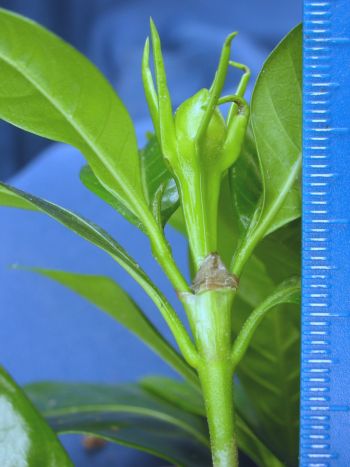Scientific Name:
Gardenia jasminoides
Pronunciation:
gar-DEEN-yuh jazz-min-oh-EYE-deez
Common Name:
gardenia
Family Name:
Rubiaceae
Plant Type:
Flowering pot plant, Semi-evergreen
Key ID Features:
Shrubs, 0.3-3m tall; leaves opposite, most elliptic-obovate, 3-10(-25)cm long x 1.5-4(-8)cm wide, leathery, glossy, dark green, petioles 1-9mm long; flowers 4-6(-8)cm wide, white to pale yellow, (5 or)6(-8) or numerous petals when doubled, highly fragrant.
Habit:
Upright
Form:
Oval - vertical
Texture:
Medium - coarse
Mature Height:
1.3 - 2.0m
Mature Spread:
1.0 - 1.5m
Origin:
S.E. Asia / Japan / China
Hardiness Rating:
Zone 8b: (-9.4 to -7 °C)
Exposure:
Part sun/part shade, Sheltered
Soil/Growing Medium:
Acidic, Well-drained
Water Use:
Moderate
Landscape Uses:
Container planting, Cut flower or foliage, Fragrance, Indoor plant, Woodland margin
Additional Info:
Google. Cultivars shown may include G. 'Summer Snow'.
Leaf Morphology:
Form:
Simple
Arrangement:
Opposite
Texture/Venation:
Leathery, Pinnate venation
Surfaces:
Lustrous
Colour in Summer:
Dark-green
Shapes:
Elliptic, Obovate
Apices:
Acute
Bases:
Attenuate
Margins:
Entire
Bark or Stem Colour:
Green, Brown
Propagation:
Stem tip cuttings
Optimal Temp.:
High
Light Level:
High
Maintenance:
High
Other:
Provide winter protection
Pest Susceptibility:
Abiotic disorder, Aphids, Dieback, Diptera - true flies, Fungal leaf spot, Mealybugs, Mildew, Mites, Mold, Root rot, Scale insects, Thrips, Whitefly
Specific Pests:
Susceptible to various stresses, causing flower bud drop





